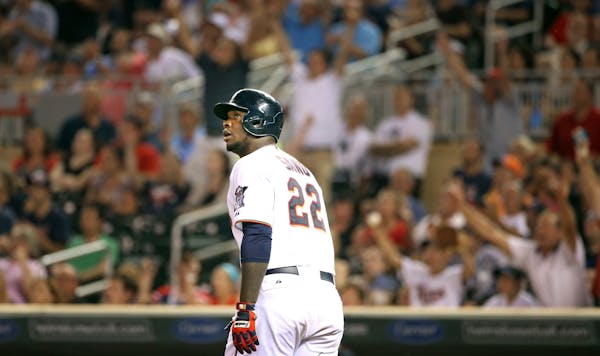I've been asked this several times per week for the past month: When was the last time the Twins had a hitter break in with the same impact as Miguel Sano?
I get the impression that, when asking this, the newer generations of Twins followers are hopeful that "never'' will be the answer.
I'd say it's close to never, depending on your definition of "break in.'' If you mean from a hitter's first chance to be in the lineup on a regular basis, I would say there is one greater force. If you mean a season in which a hitter had his first big-league at-bat, there is one challenger.
Sano hit his 14th home run in 50 games and 176 at-bats on Tuesday night. Roy Smalley, the best analyst that FSN has to offer, was on the set rather than in the booth. He eloquently made the point that came through watching on television:
No matter what the Twins might have had to say about it later, it was a rattled ballclub after rookie Tyler Duffey and then reliever Casey Fien gave away the 4-0 lead that had been built against Chicago's great lefty, Chris Sale.
The Twins were down 5-4 and looking at what would have a terrible loss to start September. And then Sano tied it in the seventh with the two-out blast into the mezzanine in left field, and as Smalley said, the tension was gone and the Twins knew they were going to win the game.
"Knew'' in this case should be interpreted as "felt very strongly,'' as opposed to the doubts that had to creep in after seeing the lead go away against Sale.
That's what Sano has done for this team: He has brought danger to the lineup, and he's done damage in the clutch.
The comparatives to what Sano has brought to the Twins are ancient when it comes to the franchise history in Minnesota.
For the impact of a rookie season, I would put only Tony Oliva in 1964 in the same category. There was no free agency, no arbitration and no concern over service time back then, so we had seen glimpses of Tony O. -- a total of 19 at-bats – in the two previous Septembers.
He started off hitting second as a rookie in 1964 and did amazing things: leading the league in hits (217), runs (109), doubles (43) and batting (.323). He also had 32 home runs and 94 RBI. He received 19 of the 20 votes for American League Rookie of the Year, with one foolish vote being cast for Baltimore pitcher Wally Bunker.
OK, Tony O. didn't hit Sano's mammoth home runs, but his impact was enormous and he captured the locals' imagination as quickly once we got to see him in the lineup on a regular basis.
As for seeing power from a hitter with no previous big-league at-bats, the challenger to Sano would be Jimmie Hall in 1963. He came out of two years spent mostly in military service to hit 33 home runs with 80 RBI in 497 at-bats for that collection of slugging Twins.
The 33 home runs were the most-ever in the American League for a player without a previous at-bat in the big leagues.
As with Sano, Hall was embraced quickly by Twins fans when the home runs started to fly. Still, it was tough to stand out in the crowd for the '63 Twins, with Harmon Killebrew hitting 45 home runs, Bob Allison 35, Earl Battey 26 and Don Mincher 17 (in 225 at-bats).
As a team, the 1963 Twins hit more home runs (225) than doubles (223).
Right now, Sano has the Twins' stage to himself much more than did Hall when it comes to bringing danger to big moment
*IN AN UNRELATED MATTER, I have to get this out there before kickoff. The Gophers are going to knock off TCU on Thursday night.
Late kickoff, the visitors sitting around all day feeling more and more pressure from that No. 2 rating, facing a Gophers secondary that can cover the receivers and a Gophers offense that is going to hold the football …
TCU is in trouble. I feel it.
Sano, Teddy Bridgewater, all our young heroes, are going to have to stand aside as this becomes a Gophers' football state again for a few days.
No satire, no sarcasm.
Gophers 31, TCU 30 (just like Miami over Nebraska in the 1984 Orange Bowl).
Soar, slide, splash? It's skiers' choice as spring's wacky pond skimming tradition returns
WADA confirms it cleared Chinese swimmers to compete at Tokyo Games citing contaminated samples

